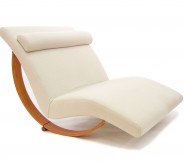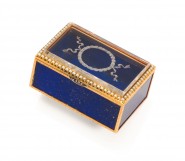Lot #27 - Johnny Warangula (Tjupurrula)
-
Auction House:Mossgreen
-
Sale Name:Australian Indigenous & Oceanic Art
-
Sale Date:21 Jul 2015 ~ 6.30pm
-
Lot #:27
-
Lot Description:Johnny Warangula (Tjupurrula)
(circa 1932-2001)
Water Dreaming with Bush Tucker (1972)
synthetic polymer paint on composition board
58 x 48 cm -
Provenance:Geoffrey Bardon, Sydney; By descent; Private Collection, Sydney
-
Exhibited:On long-term loan to the National Gallery of Australia, Canberra (1990-2014)
-
References:Geoffrey Bardon, Papunya Tula: Art of the Western Desert, Ringwood: McPhee Gribble, 1991, pp.56-7 (illus.); S. Crossman and J.P. Barou, Peintres Aborignes d'Australie, Indigne editions, Montpellier, France, 1997a, p.43 (illus.); Geoffrey Bardon and James Bardon, Papunya, A Place Made After the Story: The Beginnings of the Western Desert Painting Movement, Melbourne: The Miegunyah Press, 2004, p.356, ptg.307 (illus.); This painting appears in a film produced by Geoffrey Bardon, A Calendar of Dr
-
Notes:Johnny Warangula (1918 - 2001) was a painter's painter. The virtuosic energy of Water Dreaming with Bush Tucker demonstrates Warangula's rapid grasp of the potential of his new media. Created only a year after he commenced painting with acrylics, Warangula's great achievement was to create images of compelling spontaneity, while celebrating his country and the ceremonies that recall its formation. Warangula's inspiration emanated from his ancestral association with Kalipinypa, Tjikarri, Kampurarrpa and a constellation of interlinked sites in sandhill country in the vicinity of the Northern Territory /Western Australian border near the Tropic of Capricorn. Water Dreaming with Bush Tucker is unusual, even within Warangula's diverse variations of Kalipinypa, for it portrays a woman and child, rather than Winpa, the Lightening ancestor usually associated with the site. The striking use of figuration suggests the painting's narrative intent. The tracks of a woman and child can be traced following the sinuous lines at the perimeter of the composition. Bardon notes: 'This painting tells the story of a long search by a woman and her child for bush tucker over an area where there are many waterholes, these waterholes are marked by concentric circles...these markings are a map, though not to scale'. The tumescent appendages attached to sinuous lines represent Yala, the Desert Yam (Ipomoea costata). Mick Namarari Tjapaltjarri, Yam Dreaming with Bush Tucker Bounty (1972-3) employs very similar iconography to represent the plant's spreading form.2 Indeed Yala is strongly affiliated with the Water Dreaming site of Kalipinypa, for the drenching rain associated with the ancestral storm stimulated the plant's increase. Walter Tjampitjinpa, who was the senior custodian of Kalipinypa in the early 1970s, painted Wild Potato Story (1972, private collection) a work that focuses on the growth of the plant at the site. Tjampitjinpa's version can be regarded as a prelude to the episode depicted in the current painting. Desert Yams are an important source of food and moisture across northern Australia. Visible as a looping, vine-like shrub, the plant's growth above ground is mirrored below the earth with radiating roots producing large tubers that retain their moisture long after rain. Tubers are located by telltale cracks in the earth's surface created by pressure from Yala's swelling tubers, then harvested, using meter-long yam sticks. The paths of the woman and child in Water Dreaming with Bush Tucker can be read as they search for cracks that follow the growth of the Desert Yam. Western Desert art routinely operates at two or more levels and it is worth pausing to consider a painting's ambiguities and deeper references. In this instance, Warangula reveals the ceremonial celebration of the Dreaming by male performers, as well as telling the story of a woman and her child as they search for the Yala. Bardon refers to a 'ceremonial area' that is demarcated by the area of red dots running through the centre of the composition.3 Typically, a ceremonial area is cleared of all vegetation and hardened, then ground designs are prepared for performers who will reenact episodes from the Dreaming. At this level of interpretation, the stripes and dots on the figures represent the body paint of the performers, while the line emanating from the central roundel depicts a ceremonial pole topped with feathers. The presence of bullroarers indicates the area is restricted and for the use of initiated men only. Warangula is widely recognized for the directness and fluidity of his gesture, but the source of his signature brushwork has not been thoroughly investigated. The linguist, Jennifer Green, has recently employed a 'multimodal' approach to her analysis of 'sand story'. By scrutinizing how tellers draw figures in the sand, in combination with gesture and various distinctive ways of speaking, Green described how Indigenous narrators animate their 'sand stories'.4 Warangula was a storyteller of memorable conviction, a quality that infuses his paintings.5 Photographs of Warangula reveal he was an especially animated storyteller, pointing and gesticulating, if he was not painting or singing. The line evident in Water Dreaming with Bush Tucker is generated from the core of the artist's body, before the brush touches the surface the board. Hence Green's notion of 'motion in space' provides an apt descriptor for the narrative drive and the celebrated painterly quality of Warangula's best work.6 Green's analysis of 'gesture' can provide a lens through which we can understand Warangula's paintings dynamically, as if in the 'act of painting', rather than immutable preordained compositions. Bardon acquired Water Dreaming with Bush Tucker at the point of production and the painting was later loaned to the National Gallery of Australia for twenty-five years. Consequently, Water Dreaming with Bush Tucker is in remarkably good condition, its fluid brushstrokes retaining their original spellbinding immediacy. Bardon has described Johnny Warangula's Water Dreaming series of 1971-1973, as 'the finest achievement of the Western Desert Painting Movement.'7 Water Dreaming with Bush Tucker is a lively example of the series that embodies Paul Klee's dictum: In the final analysis, a drawing simply is no longer a drawing, no matter how self-sufficient its execution may be. It is a symbol, and the more profoundly the imaginary lines of projection meet higher dimensions, the better.8 John Kean 1 Geoffrey Bardon and James Bardon, Papunya: a place made after the story: the beginnings of the Western Desert Painting Movement, Miegunyah Press, Carlton, 2004, p. 356 2 Ibid, p. 317 3 Ibid, p. 356 4 Jennifer Green, Drawn from the Ground: Sound, Sign and Inscription in Central Australian Sand Stories, Cambridge University Press, Cambridge, 2014, pp. 71-99 5 John Kean, 'Johnny Warangula Tjupurrula: painting in a changing landscape,' Art Bulletin of Victoria, 2001, 41, pp. 47-54 6 Green, 2014, pp. 115-128 7 Bardon and Bardon, 2004, p. 32 8 Paul Klee (author) Felix Klee (editor), The Diaries of Paul Klee 1889-1918, University of California Press, Oakland, 1968, p. 183
-
Estimate:A$80,000 - 120,000
-
Realised Price:
-
Category:Art
This Sale has been held and this item is no longer available. Details are provided for information purposes only.










